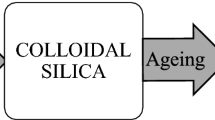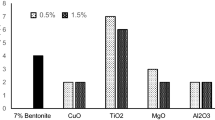Abstract
An experimental study of the rheology and lubricity properties of a drilling fluid is reported, motivated by applications in highly deviated and extended reach wells. Recent developments in nanofluids have identified that the judicious injection of nano-particles into working drilling fluids may resolve a number of issues including borehole instability, lost circulation, torque and drag, pipe sticking problems, bit balling and reduction in drilling speed. The aim of this article is, therefore, to evaluate the rheological characteristics and lubricity of different nano-particles in water-based mud, with the potential to reduce costs via a decrease in drag and torque during the construction of highly deviated and ERD wells. Extensive results are presented for percentage in torque variation and coefficient of friction before and after aging. Rheology is evaluated via apparent viscosity, plastic viscosity and gel strength variation before and after aging for water-based muds (WBM). Results are included for silica and titanium nano-particles at different concentrations. These properties were measured before and after aging the mud samples at 80 °C during 16 h at static conditions. The best performance was shown with titanium nano-particles at a concentration of 0.60% (w/w) before aging.


























Similar content being viewed by others
References
Abdo J, Haneef MD (2013) Clay nano-particles modified drilling fluids for drilling of deep hydrocarbon wells. Appl Clay Sci 86:76–82
Ahmet S, Mustafa VK, Reha O (2013) Performance analysis of drilling fluid liquid lubricants. J Pet Sci Eng 108:64–73
Al-Yasiri MS, Al-Sallami WT (2015) How the drilling fluids can be made more efficient by using nanomaterials. Am J Nano Res Appl 3:41–45
Amanullah Md, Al-Arfaj MK, Al-Abdullatif Z (2011) Preliminary test results of nano-based drilling fluids for oil and gas field application. In: SPE drilling conference and exhibition, Amsterdam, The Netherlands, March 1–3 SPE/IADC 139534. https://doi.org/10.2118/139534-ms
Bég OA, Basir MFM, Uddin MJ, Ismail AIM (2017) Numerical study of slip effects on asymmetric bioconvective nanofluid flow in a porous microchannel with an expanding/contracting upper wall using Buongiorno’s model. J Mech Med Biol 17(5):1750059. https://doi.org/10.1142/s0219519417500592
Behnamanhar H, Noorbakhsh SS, Maghsoudloojafari H (2014) Environmentally friendly water-based drilling fluid for drilling of water-sensitive formations. J Pet Gas Explor Res 4(4):60–71
Bu H, Sun J, Wang C, Bu P (2013) Rheological properties of polymer-gel drilling fluids at high temperature and pressure. Chem Technol Fuels Oils 48(6):449–458
Choi SUS (1995) Enhancing thermal conductivity of fluids with nanoparticles. Development of applications of non-Newtonian flows. ASME J Fluids Eng 66:99–105
Dantas APT, Leite RS, Nascimento RCAM, Amorim LV (2014) The influence of chemical additives in filtration control of inhibited drilling fluids. Braz J Pet Gas 8(3):097–108
Dingsøyr E, Pedersen E, Taugbøl K (2004) Oil based drilling fluids with tailor-made rheological properties: results from a multivariate analysis. Annu Trans Nord Rheol Soc 12:10–23
FANN (2016) http://www.fann.com/fann/products/supplies-and-reagents/lab-equipment-supplies/blenders-and-mixers/mixers-hb.page. Accessed 10 Dec 2017
Fazelabdolabadi B, Khodadadi AA, Sedaghatzadeh M (2015) Thermal and rheological properties improvement of drilling fluids using functionalized carbon nanotubes. Appl Nanosci 5(6):651–659
Gray GR, Darley HCH, Rogers WF (1980) Composition and properties of oil well drilling fluids. Gulf Publishing Company, Houston
Hughes B (1995) INTEQ. Drilling Engineering Workbook. Baker Hughes INTEQ, Houston, Texas, USA
Huminic G, Huminic A (2012) Application of nanofluids in heat exchangers: a review. Renew Sustain Energy Rev 16:5625–5638
Hung YH, Gu HJ (2014) Multiwalled carbon nanotube nanofluids used for heat dissipation in hybrid green energy systems. J Nanomater. https://doi.org/10.1155/2014/196074 (Article ID: 196074)
Hwang Y, Lee J, Lee J, Jeong Y, Cheong S, Ahn Y, Kim S (2008) Production and dispersion stability of nano-particles in nanofluids. Powder Technol 186(2):145–153
Jin L, Yue D, Xu Z-W, Liang G, Zhang Y, Zhang J-F, Zhang X, Wang Z (2014) Fabrication, mechanical properties, and biocompatibility of reduced graphene oxide-reinforced nanofiber mats. RCS Adv 4(66):303–35041
Kaloudis E, Papanicolaou E, Belessiotis V (2016) Numerical simulations of a parabolic trough solar collector with nanofluid using a two-phase model. Renew Energy 97:218–229
Kannaiyan K, Anoop K, Sadr R (2016) Effect of nano-particles on the fuel properties and spray performance of aviation turbine fuel. ASME J Energy Resour Technol 139(3):032201-1–032201-8
Lvov YM, Pattekari P, Zhang X, Torchilin V (2011) Converting poorly soluble materials into stable aqueous nanocolloids. Langmuir 27(3):1212–1217
Mostafavi V, Ferdous MZ, Hareland G, Husein M (2011) Design and application of novel nano drilling fluids to mitigate circulation loss problems during oil well drilling operations. J Clean Technology. ISBN:978-1-4398-8189-7
OFITE (2014) OFI Testing Equipment, Inc. http://www.ofite.com/products/product/43-mud-balance-4-scale-metal. Accessed 14 Dec 2017
Olatunde AO, Usman MA, Olafadehan OA, Adeosun TA, Ufot OE (2012) Improvement of rheological properties of drilling fluid using locally based materials. Pet Coal 54(1):65–75
Qu Y, Lai X, Zou L, Su Y (2009) Polyoxyalkyleneamine as shale inhibitor in water-based drilling fluids. Appl Clay Sci 44(3):265–268
Slawomir R, Zbigniew KB, Malgorzata U (2009) Study on the application of starch derivatives as the regulators of potassium drilling fluids filtration. Chem Chem Tech 3:107–202
Tian Y, Zhang X, Geng H-Z, Yang H-J, Li C, Da S-X, Lu X, Wang J, Jia S-L (2017) Carbon nanotube/polyurethane films with high transparency, low sheet resistance and strong adhesion for antistatic application. RSC Adv 7(83):53018–53024
Yang S, Hou Y, Zhang B, Yang XH, Zhang H, Zhao HJ, Yang HG (2014) Precisely controlled heterogeneous nucleation sites for TiO2 crystal growth. CrystEngComm 16:7502–7506
Yang S, Huang N, Jin YM, Zhang HQ, Su YH, Yang HG (2015) Crystal shape engineering of anatase TiO2 and its biomedical applications. CrystEngComm 17:6617–6631
Zakaria M, Husein MM, Harland G (2012) Novel nano-particle-based drilling fluid with improved characteristics. In: SPE international oilfield nanotechnology conference and exhibition, 12–14 June, Noordwijk, The Netherlands
Acknowledgements
The authors are grateful to the reviewers for their insightful comments which have served to significantly improve the present article.
Funding
This research did not receive any specific Grant from funding agencies in the public, commercial, or not-for-profit sectors.
Author information
Authors and Affiliations
Corresponding author
Ethics declarations
Conflict of interest
The author(s) declared no potential conflicts of interest with respect to the research, authorship, and/or publication of this article.
Additional information
Publisher’s Note
Springer Nature remains neutral with regard to jurisdictional claims in published maps and institutional affiliations.
Rights and permissions
About this article
Cite this article
Bég, O.A., Espinoza, D.E.S., Kadir, A. et al. Experimental study of improved rheology and lubricity of drilling fluids enhanced with nano-particles. Appl Nanosci 8, 1069–1090 (2018). https://doi.org/10.1007/s13204-018-0746-4
Received:
Accepted:
Published:
Issue Date:
DOI: https://doi.org/10.1007/s13204-018-0746-4




